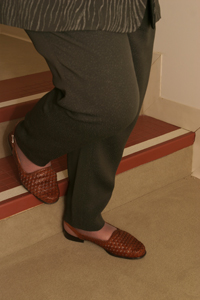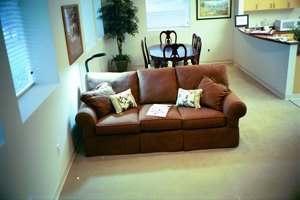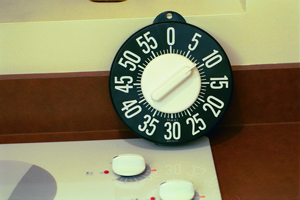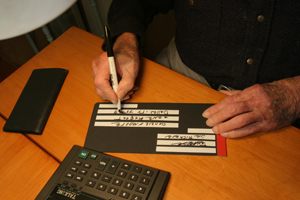Apartment Survey Tour and Checklist
Home Exterior
- Are the curb and outside steps marked with a contrasting color to make them more visible?
- Are glass doors marked with tape or some other marker to make them more visible?
- If there is a wheelchair ramp, does it have a nonskid surface?
Common Areas
Mailbox Area
- Is the area brightly lit so you can locate the right mailbox?
- Are the names and numbers on the mailboxes large and easy to read?
- Is your mailbox marked with brightly colored dot or label to make it easy to find?
Lobbies and Hallways
- Is lighting uniform throughout? Is there glare in any area?
- Is there contrast in the color of the doors and baseboards compared to the wall color?
- Is there any equipment or debris in the halls that can create a safety hazard?
- Are ramps identifiable by a tactile change in surface (from carpet to concrete, for example)?
- Are emergency exits clearly marked?
- Are floors cleaned/waxed with a non-glare, non-slippery finish?
- Are signs at eye level? Is there adequate lighting to read them? Is the print large enough to be read?
Stairways and Elevators

- Are stairways clearly lit?
- Are the edges of steps marked in a contrasting color and texture to make them easy to see and navigate?
- Do handrails extend beyond the stairwell for extra safety?
- Are handrails in contrasting color to the walls?
- Are the tops of landings marked in a contrasting color and texture?
- Do the elevators have exterior floor signs marked with large numerals for floor identification?
- Are the up and down light indicators of elevators easy to see?
- Can floor buttons in elevators be identified by both sight and touch?
- Does the elevator identify floors by an audible signal or a recorded voice announcement?
Home Interior
General items
Learn more about these tips in Lighting and Glare and Contrast.
- Are entrance thresholds flush with the floor?
- Is there contrast in the color of the doors and baseboards compared to the wall color?
- Is there color and texture contrast in your floor coverings (such as carpet or tiles)?
- Have window treatments been designed to control glare and maximize natural light?
Hallways
- Is lighting uniform throughout? Is there glare in any area?
- Does the lighting create any shadows?
Living Room
- Is there adequate lighting for reading, writing, sewing, or other tasks?
- Is glare a problem? What about mirrors? Flooring? Bright sunlight on glass tabletops?
- Are throw rugs nonskid?
- Is there furniture in the middle of the floor that could cause safety issues?
 | Throw pillows in colors that contrast with the couch
make furniture easier to see. |
- Are there designated locations to keep keys, TV remotes, and other small, easily misplaced items?
- Is the TV located in a place where viewing isn’t affected by glare?
- Have raised or brightly colored markings been applied to thermostats to make commonly used settings easy to find?
Bedroom
Learn more about these tips in the Bedroom section.
- Is there adequate lighting for reading, writing, sewing, or other tasks?
- Is glare a problem? What about from mirrors? Flooring? Bright sunlight on glass table tops?
- Are throw rugs nonskid?
- Is there furniture in the middle of floor that could cause safety issues?
- Are there designated locations to keep keys, TV remotes, and other small, easily misplaced items?
- Is the TV located in a place where viewing isn’t affected by glare?
- Have closets and drawers been organized to make it easy to match clothing?
Kitchen
Learn more about these tips in the Kitchen section.
Is there contrast in colors or textures on walls, woodwork, floor coverings, and cabinet surfaces?
Have brightly colored or raised markings been applied to the stove and other appliances to facilitate cooking?
Is there a system in place for organizing the cupboards and refrigerator items—such as the use of tactile markings, large-print lettering, or other means to identify cans, items in the refrigerator, or frozen food containers?Has the kitchen been equipped with adaptive equipment, such as large-print or raised-line measuring cups and spoons, long oven mitts, liquid level indicators for pouring hot and cold liquids, color-contrast cutting boards, kitchen timers with large numbers, and talking or tactile thermometers?

Large timer

Have all flammable or combustible items been removed from the cooking area?
Have smoke alarms and fire extinguishers been installed? Do you know how to use them?
Are cleaning products, insect sprays, etc., clearly labeled and safely stored?
Home Office

- Is there a filing system for bills and important papers that is easy to follow? For example, are folders color-coded, or do they have large print or braille labels?
- Is there a system for keeping track of appointments, important phone numbers, and addresses?
- Do you have a writing guide set with signature, letter-writing, and envelope writing guides, bold or raised line paper, and bold pens such as 20/20 pens?
- Is there a good light available for close work?
- Do you have a telephone with large-print numbers or tactile markings?
- If you are using a computer, has it been adapted with screen magnification or speech?
- Do you have devices such as magnifiers or scanners to enable you to read mail or other documents?
- Do you have a calculator with large print displays or speech?
Bathroom
Learn more about these tips in the Bathroom section.
- Has color contrast been used effectively with walls, woodwork, floor coverings, and cabinet surfaces? (An example of effective contrast would be placing dark towels against a light wall
- Are bathroom fixture handles, door handles, and soap dishes or dispensers in colors that contrast with surfaces and walls?
- Has the hot water setting in the tub been marked so it can be identified by touch or through use of contrasting colors?
- Is there sufficient and appropriate lighting in the bathroom?
- Is there too much glare? White-tile bathrooms are particularly prone to glare.
- Are there nonskid mats in the bathtub and on the floor?
- Is the bathroom equipped with adaptive devices such as a talking scale, pill organizer, and magnifying mirror?
- Is the mirror easily accessible without having to lean over a sink?
- Have pill bottles been organized and identified properly with large-print, tactile, or color-coded labels?
- Is the floor covering non-glare and non-slip?
Laundry Room
Learn more about these tips in the Laundry Room section.
- Have brightly colored or raised markings been applied to the washer and dryer to facilitate their use?
- Do you have a system for sorting your lights and darks, and for keeping matching socks together?
- Is there a place to hang and sort clothing?
- Are large-print or tactile measuring devices available to measure laundry detergent?
- Are detergents and bleaching agents clearly marked?
Dining Area
- Has the table setting been designed to maximize contrast between the tablecloth or placemats, plates, cups, and silverware?
- Have contrasting colors been used to differentiate the floor covering and tablecloth?
- Can glare from windows be controlled?
This completes your home survey. If there are items that you have not been able to check off as accomplished or in place, please go to Lighting and Glare and Redesigning Your Home for tips on making necessary changes to help ensure a safe home environment.